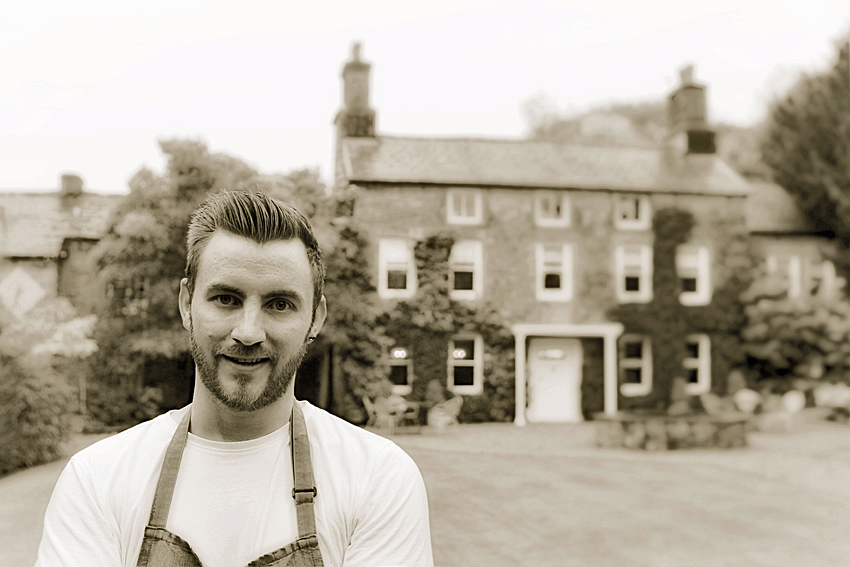
At the age of 28, Head Chef Oli Martin has developed a distinctive style of cuisine that reflects his unusually wide experience. After his first position at a one rosette restaurant (four years), cooking in a French village restaurant taught him the importance of shopping in local markets for the freshest produce. Returning to England, his skills were sharpened in the kitchens of Northcote Manor and Gilpin Lodge where he spent three years.
Time out in Asia and working in Sydney for a year expanded his culinary horizons, and a period in outside catering also helped prepare him for his current role. Amazingly, in just three months after taking up the post in January 2015, his cooking was awarded three rosettes by the AA guide, confirming Hipping Hall’s position as a destination restaurant with rooms.
Oli particularly enjoys cooking with fish and vegetables, especially roots, which offer greater outlet for his creativity and which feature heavily in his menus. He is in the early stages of developing his own kitchen garden, already achieving self-sufficiency in herbs and berries. Not an expert forager, he uses what is easily available and forages himself on Sunday afternoons.
Having built up good relations with established suppliers of core ingredients, and benefitting from specialist produce such as locally shot venison, Oli has developed seasonally changing tasting and a la carte menus, catering for a maximum of 32 covers.
There is healthy take up on the tasting menus, with the shorter one at lunch being more adaptable, allowing greater scope to experiment with dishes. Saturday and Sunday lunches are extremely popular with locals – the term includes those from a wide radius, this being a rural area – whilst those from further afield often return to enjoy the tasting menus.
Oli is refreshingly hesitant in giving his cuisine a distinct label other than “flexible.” With its roots firmly in the classics, his cooking shows innovation and a degree of playfulness. Menu descriptions are terse, listing the few ingredients but giving no idea of cooking methods. This results in a less cluttered, cleaner approach, with the main ingredient taking centre stage. Contrasting textures and strong flavours to are fully evident. Not that the dishes are easy to execute, as their essential simplicity offers no room to hide, requiring accurate timing, harmonious combinations and attractive, often rustic, presentation.
Fine Dining Guide sampled Oli’s eight course tasting menu on a weekday evening in April
Pre-prandial cocktails with canapes and a dainty amuse bouche served their purpose in stimulating the taste buds
Spent bread which accompanied the tasting menu was exemplary in texture and had a pleasant slightly sweet and malty flavour.
The first course of marinated trout was lively and vibrant, the rich flavour and firm texture balanced by the acidity and softness of a yogurt dressing. Wine: Chablis, Chateau Beru, France, 2013.
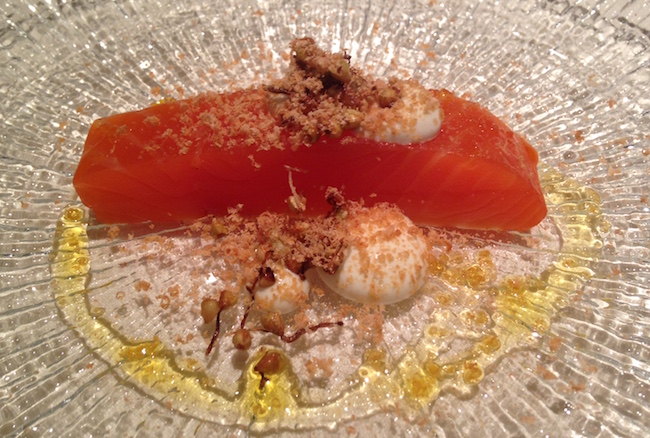
An innovative dish of aged duck partnered thin strips of salted and air dried Lancashire duck breast – a process over thirty days long – with beetroot which added sweetness and grapefruit which gave a gentle bitterness to cut the richness of the duck. Again, textural complexity came first, then the taste combinations which worked well together. Wine: Dry-Furmint, DOBOGO, Tokhai, Hungary, 2013
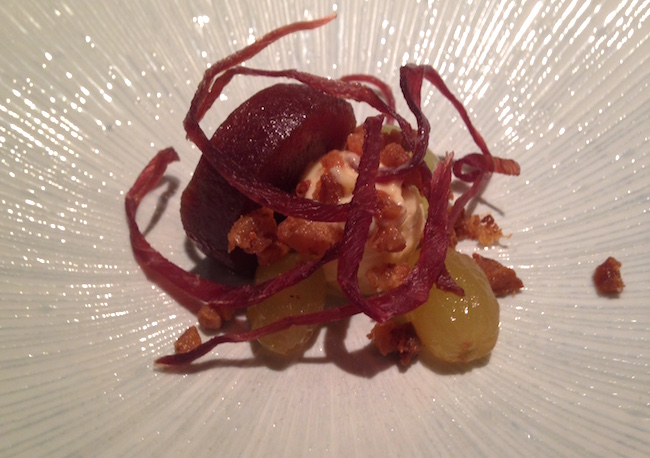
A Dover Sole fillet was precisely timed to capture its delicate taste and the firm texture of the flesh. Diced rhubarb and homemade lardo added harmonious sweet and savoury notes that did not overpower the fish. Wilted chard completed this simple yet elegant dish.
Wine: Lugana Ca L’Orjero, Veneto, Italy, 2014.
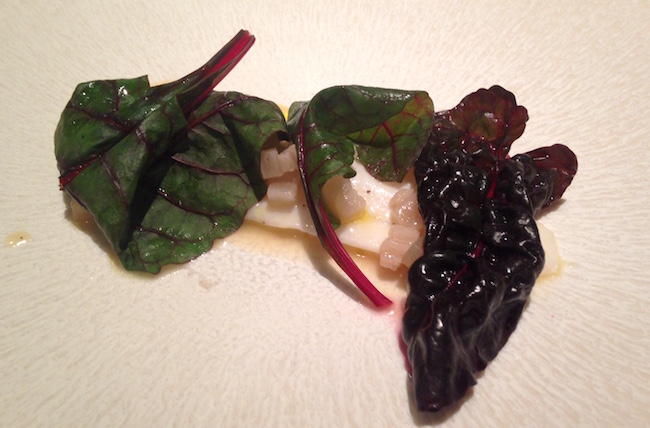
A medium rare pigeon breast benefitted from being cooked sous vide then finished in the pan. Succulent and gamey, avoiding the livery texture inferior cooking brings, it showed skill in timing and seasoning. Hazelnut butter provided a complementary earthy note, wild leeks gave texture and elderflower gel added the sweetness the dish needed. Overall this was another well balanced, precisely executed and beautifully presented dish. Wine: Barbera D’Alba, Ciabot Contessa, Umberto Fracassi, Piemonte, Italy 2011

A moist, sweet tranche of monkfish had been lightly seared then marinated in lemon juice. Its robust qualities, both in texture and flavour, were complemented by an intense aerated fish bisque. Strands of monk’s beard added a spinach like taste to dress the fish.
Wine: Nebbiolo, Costa Bassa, Marco Fay, Lombardia, Italy, 2014
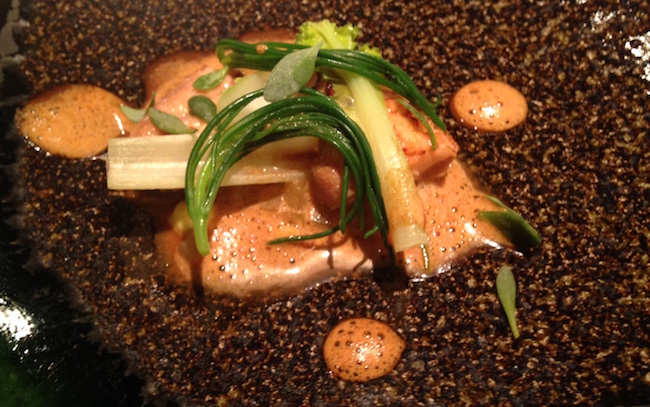
Loin of venison was another masterclass in game cookery. Seared and properly rested, it was a triumph of gentle gamey flavour and buttery texture. A pepper crumb added a contrasting crunch, shitake mushrooms an earthy richness, whilst wild garlic puree gave a herbal lift.
Wine: Cru-Elles, Ludovik Engelvin, Languedoc, France, 2014
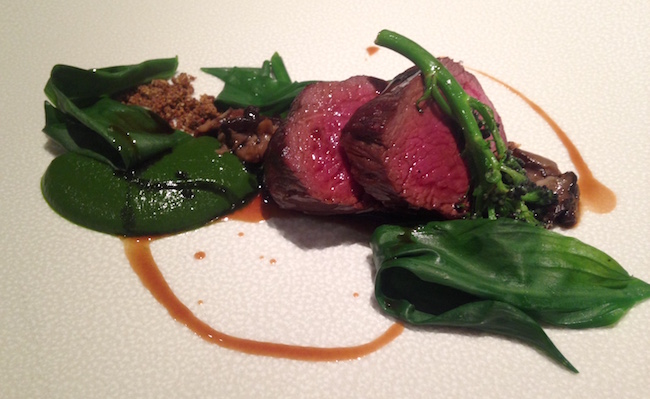
A refreshing pre dessert provided a veritable explosion of tastes, textures and temperatures. Salted yoghurt, puffed wild rice and mint and cucumber granite worked well together in cleansing and enlivening the palate.
The menu description for the next course, Lancashire Cheese, Spiced bread totally understated the playful invention of this unique dessert. The slightly salted, silky ice cream was sandwiched between biscuits made with the spices used in Eccles cakes and given sweetness with the addition of golden sultanas. A smoking cinnamon stick dipped into iced tea proved a novel twist to this delicious, witty version of afternoon tea.
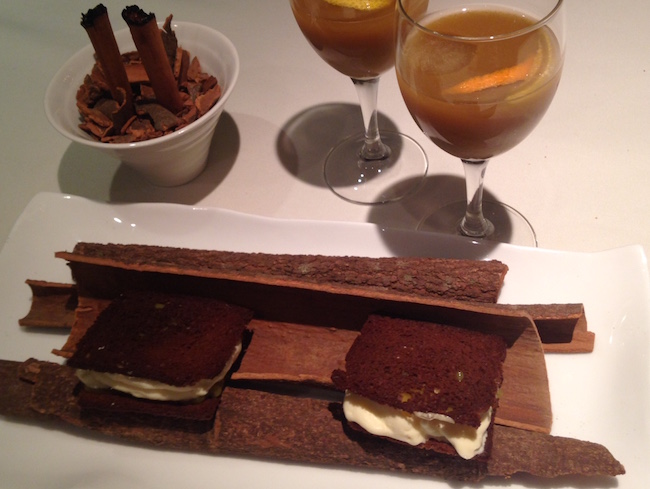
A signature dessert of Chocolate sphere, mandarin, truffle has become so popular is stays on the menu from September to March. Vanilla and chocolate custard encased in the delicate tempered sphere was dressed with hazelnut praline; caramel and feuillantine pastry. Truffle shavings running through the dish gave a heady fungal earthiness to balance the sweetness of the dish. Mandarin sorbet of velvety smoothness and deep intensity gave contrasting taste, texture and temperature. This original, beautifully presented composite dessert, demanding a high degree of technical skill, confirmed the strengths of the pastry section.
Wine: Voudomato, Hazidakis, Santorini, Greece, 2007
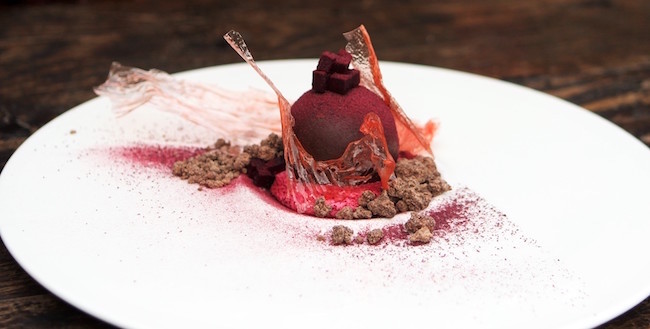
Coffee and petit fours completed a memorable meal. This was enhanced by a judiciously chosen flight of wines to complement the savoury and sweet courses In particular, the Umberto Fracassi with the pigeon and Santorini with the chocolate sphere were inspired choices.
The welcoming, engaging and knowledgeable service, especially that of Clare Duthie who presented the dishes and wines, showed the front of house, ably organised by restaurant manager Rob Scott, was on top form.
Overall, the meal we enjoyed at Hipping Hall was an unpretentious virtuoso performance showing consummate skill and mastery of a variety of techniques which do full justice to high quality ingredients. Yet, at just 28, Oli Martin has clearly has not reached the peak of his powers and has so much more to give. Having elevated the cuisine of Hipping Hall to lofty heights in so short a time, further accolades are well within his grasp. Fine Dining Guide will follow his career with interest and awaits the publication of the food guides, especially Michelin, in eager anticipation.



